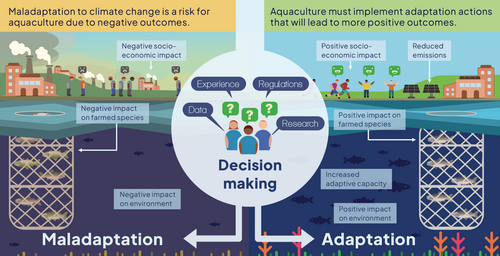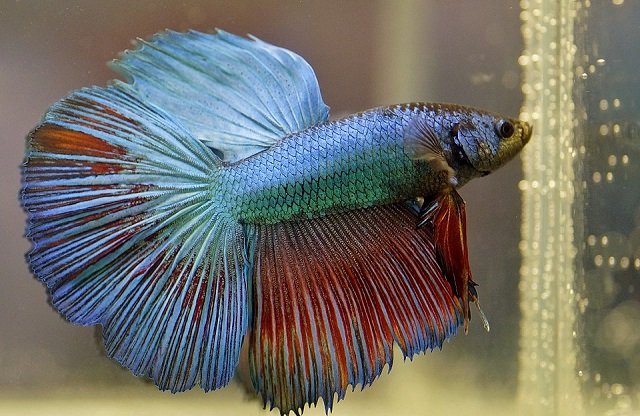
As the impacts of climate change intensify—from marine heatwaves to extreme storms—the aquaculture sector finds itself in an urgent race to adapt. The industry must implement strategies to mitigate risks and enhance resilience. However, a new study published in Reviews in Aquaculture warns of a significant peril: maladaptation.
Maladaptation is a critical concept: it refers to an action introduced with the intent to minimize a negative climate effect, but which, ironically, ends up exacerbating the situation, increasing vulnerability, or generating other undesirable impacts.
The study, led by researcher Lynne Falconer from the Institute of Aquaculture at the University of Stirling, explains that maladaptation can arise unintentionally and at any stage of the production chain, threatening the future sustainability of the sector.
Key findings
- Maladaptation occurs when an action intended to reduce climate risk ultimately worsens the situation, increases vulnerability, or creates new problems.
- The study identifies six key maladaptation outcomes specific to aquaculture: increased GHG emissions, negative impacts on farmed species, negative ecological impact, negative social impact, negative economic impact, and reduced adaptive capacity.
- Maladaptation is not an obvious failure; it exists on a continuum where the boundaries between successful and failed adaptation are blurred and can shift over time.
- Clear examples include the high energy consumption of RAS (if using fossil fuels) or the introduction of non-native species that spread disease.
- To avoid it, strategies for monitoring, trade-off assessment, and a focus on the specific context of each operation are required, rather than generalized solutions.
What is maladaptation in aquaculture?
Adaptation to climate change (the process of adjusting to current or anticipated climate changes) is not a simple matter of “success” or “failure.” The Intergovernmental Panel on Climate Change (IPCC) describes it as a continuum. At one end lies successful adaptation; at the other, maladaptation.
An adaptation decision is rarely perfect and requires trade-offs. An action may be positive for carbon emissions but have adverse economic consequences; another may protect the farmed species but harm the local environment. The challenge is that most of these decisions are made with incomplete information regarding future climate variability, and the negative effects may take time to materialize.
To help the sector identify these risks, the study defines six key outcomes of maladaptation in aquaculture.
The six outcomes of maladaptation in aquaculture
The study details how adaptation strategies can fail, grouping the risks into six main categories.
Increased Greenhouse Gas (GHG) Emissions
An adaptation is maladaptive if, in solving a local problem, it contributes to aggravating the global problem of climate change.
Stay Always Informed
Join our communities to instantly receive the most important news, reports, and analysis from the aquaculture industry.
A clear example is the transition from conventional net pens to land-based Recirculating Aquaculture Systems (RAS). While RAS can protect fish from adverse marine conditions, their energy consumption is significantly higher. A PwC analysis estimates that RAS consumes approximately 13.6 kWh/kg of salmon produced, versus just 0.15-1.2 kWh/kg in conventional pens. If that energy is sourced from fossil fuels, the adaptation has merely shifted the problem, increasing the sector’s carbon footprint.
Negative impact on farmed species
Actions designed to alleviate one climate challenge can, inadvertently, create other problems for the health, welfare, or product quality of the farmed species.
For example, rising sea temperatures in Norway are linked to an increase in sea lice infections. As an adaptation, the use of treatments is increased. However, the intensive use of these treatments is also linked to mortality events and poor welfare in salmon. Likewise, new feed formulations seeking to reduce dependency on marine ingredients (affected by climate) may introduce health challenges if they fail to meet optimal nutritional requirements or if they introduce toxins.
Negative ecological or environmental impact
This type of maladaptation occurs when an adaptation action threatens the integrity of the surrounding environment, reduces biodiversity, or increases pollution.
A classic example is the introduction of non-native species as an adaptation strategy. If a producer decides to farm a new species that better tolerates warm temperatures, it poses a risk of escapes. These species can interact with wild populations, become invasive, and displace native species. Historically, the movement of infected bivalves (such as Pacific oysters from Asia) has been implicated in the introduction of pathogens, like ostreid herpesvirus, into new regions such as Europe.
Aquaculture does not exist in a vacuum. An adaptation can be technically successful but have adverse consequences for workers, local communities, or global food security.
The study cites an example from Bangladesh, where farmers, in response to rising sea levels and saline intrusion, converted their farmland into shrimp ponds. Although this generated employment initially (an adaptation), in the long term, it led to the salinization of drinking water, causing serious health problems for the local community. Another risk is that technological innovations (suchas RAS shrimp farming in Europe) may displace traditional producers in more climate-vulnerable countries, exacerbating inequality.
Negative economic impact
An adaptation strategy that proves to be prohibitively expensive, is not viable for small-scale producers, or generates a product that consumers are unwilling to pay for, is a form of economic maladaptation.
Large-scale technological innovations, such as RAS systems or offshore aquaculture, require high upfront investment costs. While they may reduce exposure to certain climate stressors, they also face challenges (such as water quality or fish welfare) that can affect profitability. If the only way to recoup this investment is through a “premium price” (higher), the strategy will fail if consumers do not accept such an increase.
Reduction of future adaptive capacity
Perhaps the most insidious form of maladaptation is adopting strategies that “lock us in” to a specific path, preventing flexibility for future adaptations.
This is known as “path dependency.” It occurs when so much is invested in one solution (e.g., large-scale coastal defenses) that budgets for other actions are exhausted. It also manifests as the “sunk cost fallacy”: when a producer is reluctant to change farming methods (due to costs already incurred) despite evidence showing it is a suboptimal strategy in the face of climate change.
The study also differentiates between “adaptation” and “coping.” Coping is a short-term response, like repairing pond infrastructure after a cyclone. This allows production to continue, but the system remains vulnerable. If these constant repairs prevent systemic change (like moving the pond to a safer area), coping becomes maladaptive.
How to avoid maladaptation in aquaculture
The main driver of maladaptation is poor planning. The study concludes with seven key recommendations for the sector to move toward successful climate adaptation:
- Recognize the need for context-specific adaptation: What works for one farm or species may be maladaptive for another.
- More research on combinations of stressors: Understanding how multiple climatic and non-climatic factors interact is needed.
- Test adaptation actions in different circumstances: It is vital to test solutions at a commercial scale and in different contexts before widespread adoption.
- Evaluate trade-offs in decision-making: Develop tools to weigh the advantages and disadvantages of each action.
- Facilitate knowledge exchange: Create platforms for sharing experiences among companies, regions, and sectors.
- Enable collective action: Many adaptations (like coastal defenses or legislative changes) require a joint effort.
- Develop monitoring and evaluation schemes: It is crucial to track adaptation progress to identify failures early and change strategies if necessary.
Ultimately, the study underscores that all actors in the sector must recognize the potential for maladaptation. This is not about finding a single, perfect solution, but about using adaptation as a mechanism to drive more sustainable and responsible aquaculture production in an uncertain future.
Contact
Lynne Falconer
Institute of Aquaculture, University of Stirling
Stirling, UK
Email: lynne.falconer1@stir.ac.uk
Reference (open access)
Falconer, L., Rector, M., Yakubu, S. O., Filgueira, R., Iversen, A., Mikkelsen, E., Sprague, M., & Ytteborg, E. (2026). Maladaptation to Climate Change Poses a Threat to Future Aquaculture Production. Reviews in Aquaculture, 18(1), e70114. https://doi.org/10.1111/raq.70114
Editor at the digital magazine AquaHoy. He holds a degree in Aquaculture Biology from the National University of Santa (UNS) and a Master’s degree in Science and Innovation Management from the Polytechnic University of Valencia, with postgraduate diplomas in Business Innovation and Innovation Management. He possesses extensive experience in the aquaculture and fisheries sector, having led the Fisheries Innovation Unit of the National Program for Innovation in Fisheries and Aquaculture (PNIPA). He has served as a senior consultant in technology watch, an innovation project formulator and advisor, and a lecturer at UNS. He is a member of the Peruvian College of Biologists and was recognized by the World Aquaculture Society (WAS) in 2016 for his contribution to aquaculture.



